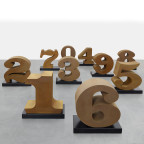Biography
For the first time, Waddington Custot will present work by two sculptors as part of Frieze Sculpture, London’s largest free display of outdoor art, held in Regent’s Park. The works presented by the gallery, by Robert Indiana and Barry Flanagan, have been selected by curator Clare Lilley (Yorkshire Sculpture Park) to be exhibited alongside sculptures by artists from across the globe.
Robert Indiana, ONE through ZERO, 1980-2002
Best known for his iconic series of LOVE sculptures, Robert Indiana was an American printmaker, painter, and sculptor. Indiana’s Cor-Ten steel ONE through ZERO, (1980-2002) presented by Waddington Custot at Frieze Sculpture, is a grouping of ten number sculptures, which was first conceived in 1980 as a series of eight-foot painted aluminium sculptures on a monumental scale. The artist later created several series of Numbers sculptures in different scales and finishes, including the Cor-Ten ONE through ZERO.
Also known as weathering steel, Cor-Ten develops a patina specific to its surrounding environment, which continuously regenerates when subjected to the influence of the weather, eventually developing a rich velvety rust-coloured appearance. Indiana was inspired by the popular, mid-19th century American tradition of narrative imagery which depicted the cycle of life as the ‘ages of man’ represented by specific numerals, from birth (1), childhood (2), adolescence to adulthood (3-6), old age (7-9) and finally death: 0.
Barry Flanagan, Composition, 2008
Barry Flanagan is one of Britain’s most celebrated sculptors. Waddington Custot present his Composition (2008), comprising a large bronze Nijinski hare, his most collected sculpture, supported by a trio of elephants performing a circus-balancing act. Flanagan had a personal affinity with performance and the Nijinski hare is named after star of Ballets Russes, Vaslav Nijinski, who was known for his exuberant dance style and was a life model for Auguste Rodin. An avid admirer of Rodin’s work, Flanagan uses his anthropomorphic hare to catch the dynamic pose of Nijinski mid-dance, adopting the same technique as Rodin by leaving his own sculptor’s thumbprint exposed on the hare’s body to enhance its sense of movement and immediacy.
Read more










